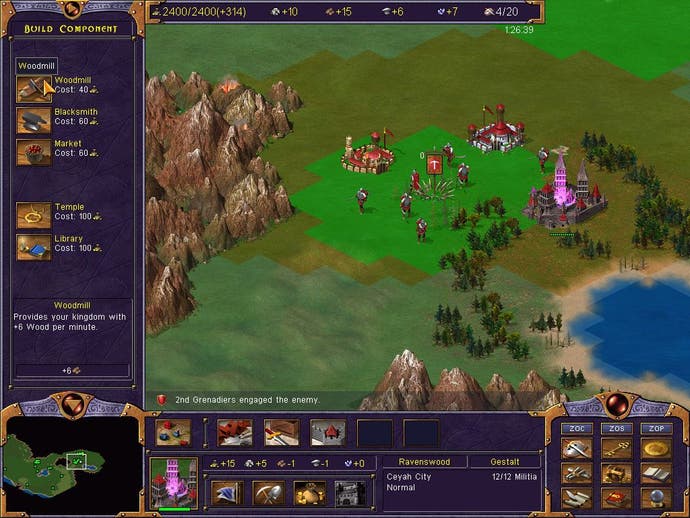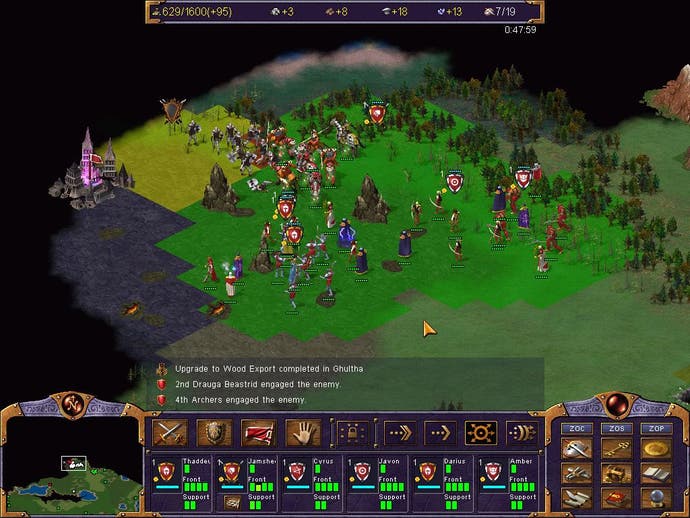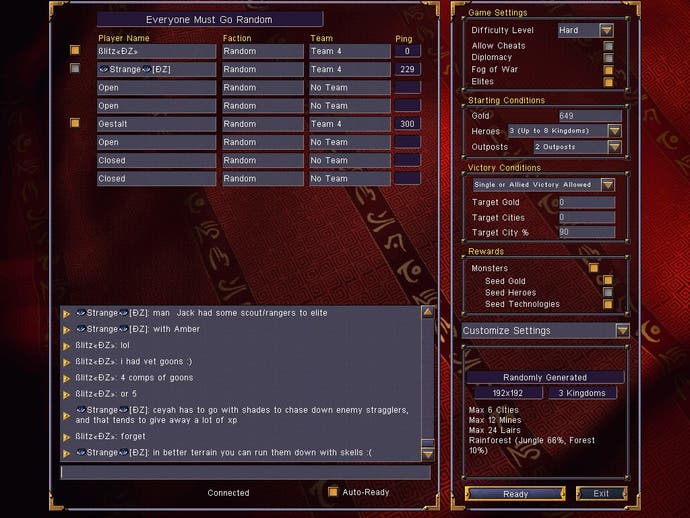Kohan : Immortal Sovereigns
Review - a role-playing / real-time strategy hybrid with a difference

And Now For Something Completely Different
In the last couple of years it seems that almost every new real-time strategy game has boasted the inclusion of "role-playing elements". Most of the time this simply meant that your army included one or more hero characters who had an uncanny knack of wandering into the middle of a battle and getting killed, resulting in a "game over" screen. The latest attempt to marry the two genres is Kohan, which has been available in the USA for several months now and is finally reaching Europe this week. Instead of cobbling a basic experience system or heroes onto an otherwise traditional strategy game though, developers TimeGate have gone back to basics and come up with something utterly unique, a fantasy strategy game which has more in common with Heroes of Might & Magic than Warcraft. Instead of harvesting resources and constructing bases all over the map, in Kohan you must fight for control over towns which are scattered around the map, or use settlers to found your own in an uninhabited area. Settlements start out as bare villages, but facilities such as blacksmiths and city walls can be added to increase the resources they produce, unlock more advanced units or provide other bonuses. When you run out of slots for building you can upgrade the settlement, allowing the growing town to house more facilities and support more units, and the individual facilities within a town can also be upgraded, with a choice of three upgrade options usually available for each.

Line Up
The way in which your troops function is radically different as well. Instead of running around individually, units are made up of four front line troops, two support troops and a leader. This can be either a standard captain or one of the eponymous immortal Kohan warriors you will discover throughout the game. These heroes provide bonuses for the troops under their command and can also wade into the fight themselves, gaining experience throughout the single player campaign. If one dies it's not the end of the world either - because they are immortal you can simply stump up some cash to re-awaken them from a magical amulet. They might lose experience, but they are at least available again. There are only a few types of infantry and cavalry which can be used as front line troops in a unit, but as you construct and upgrade temples, libraries, garrisons and other facilities in a town you will uncover a wide variety of wizards, clerics, archers and other support troops. Different combinations will provide your regiment with bonuses to their movement, morale, attack and defence skills, as well as providing ranged attacks, healing magic and other special abilities. Each of the game's five factions has its own unique range of troop types as well, and when you take over one of their towns you are able to build their units at that town, making for a bewildering array of troops and almost limitless possibilities for combining them into regiments. Not all of your soldiers are mobile either. Every settlement has its own fixed garrison of militia which will rush out to defend the town when an enemy strays too close. This leaves you free to use the majority of your army for attacking the enemy instead of defending your base, and although a strong and persistent attacker can wipe out your militia easily enough, it will at least hold them up long enough for you to rush in reinforcements. You can also use special engineer units to construct outposts, which again contain their own garrison of militia but can be built pretty much anywhere on the map. These can be perfect for holding down a choke point such as a narrow mountain pass, or to bolster the defences of a nearby town.

Risk vs Reward
All of this comes at a price though. Every regiment you command, every mine or outpost you build, and many of the facilities in your towns have an upkeep cost. Unusually though, while the game features five resources (gold, mana, stone, wood and iron), only one of them is hoarded - gold. The others are simply shown as a positive or negative number in your status bar, showing by how much your production is exceeding or falling short of demand. If you don't produce enough of any particular resource the rate at which you earn gold is reduced accordingly, but annoyingly if you have a positive flow you don't gain anything from it. This does make the game's resource system simpler, but it isn't a very satisfactory way of handling things. Why can't I stockpile a resource when my towns are producing too much, or adjust the rate at which my markets and other facilities exchange them for gold to cash in on any surplus? Combat is also a little odd. Because troops are arranged in fixed regiments, each unit must be in one of the preset formations before it can do anything. This looks great, especially with the ability to group up to six regiments into a larger formation, but once you enter battle any plans soon go to hell and you are left as a helpless bystander. All you can do is order units to retreat if things turn ugly, then wait for them to reform at the rally point before moving them elsewhere. You can't give orders to a unit unless its men are gathered around their banner, and this always remains fixed regardless of where the individual soldiers roam during a fight. So if your men go running off after a fleeing enemy, you have to wait for them all to get back to their regimental standard before you can move them anywhere else. While this does make for a more involved tactical approach to combat, it can be frustrating if you are used to the immediacy and responsiveness of other real-time strategy games and expect your men to do what they are told as soon as you give an order.

On / Off
Luckily the game includes a pair of excellent tutorial campaigns to show you the ropes, one covering the basics all the way from selecting and moving units on up, the other teaching those already familiar with the real-time strategy genre some of Kohan's more unusual features. Once you have got to grips with the interface and controls, it's time to dive into something a little more involved. At the heart of the game is a lengthy single player campaign which casts you as a resurrected Kohan lord facing an ancient evil that overthrew your kind centuries earlier. This is entertaining enough, but proved to be a little slow paced and overly easy at times. The skirmish mode shows the AI in a better light though. Having just completed the campaign with little difficulty I was getting a bit complacent, and the AI promptly pulverised me in the space of ten minutes. I won't be making that mistake again... Where the game really shines though is in multiplayer. An in-game server browser allows you to instantly find other players and chat with them while you wait for a game to fill up, and even though Kohan has yet to be released in Europe there are plenty of American players already online. As in skirmish mode you have a choice of using pre-designed or random maps, with a variety of options to tinker with starting conditions, terrain types and so forth. Epic team battles with four players on each side battling across massive maps are surprisingly common and a lot of fun. It's much faster and more furious than in single player, and you have the ability to exchange technology, cities and money with your allies. The game even comes with an easy-to-use editor which allows you to create your own custom maps for online or offline play.
Conclusion
Kohan is one of the most innovative real-time strategy games we have come across in recent years, reinvigorating the genre with features more usually found in turn-based titles. It's not perfect - the resource system is a little odd and the lack of direct control over units may prove an irritation for hardcore stategy fans at first - but it does make a refreshing change from your typical Command & Conquer clone. With an extensive story-led camapign to ease you into the action, an accomplished skirmish mode for solo players and excellent online support, it's well worth a look.

